Most companies don’t fail because of bad strategy. They fail because good strategies never make it off the page. Leaders blame lack of resources, poor communication, or shifting priorities, but the real culprits are hidden in plain sight: their own behaviors.
This book reveals the three most destructive leadership habits that quietly sabotage execution, erode trust, and breed change resistance. Drawing on decades of research and real-world case studies, it uncovers how these patterns ripple through culture, fragment alignment, and leave employees cynical about every “new initiative.”
Most importantly, it introduces a practical and transformative solution -- a one-page behavioral framework that translates lofty strategies into living, breathing, everyday actions.
With vivid examples and immediately applicable tools, it shows leaders how to redirect unproductive energy, align their organizations, and embed strategy into daily decisions.
Whether you’re a CEO, a department head, or an ambitious professional, this book will equip you with the clarity and confidence to turn strategic aspirations into sustained results.
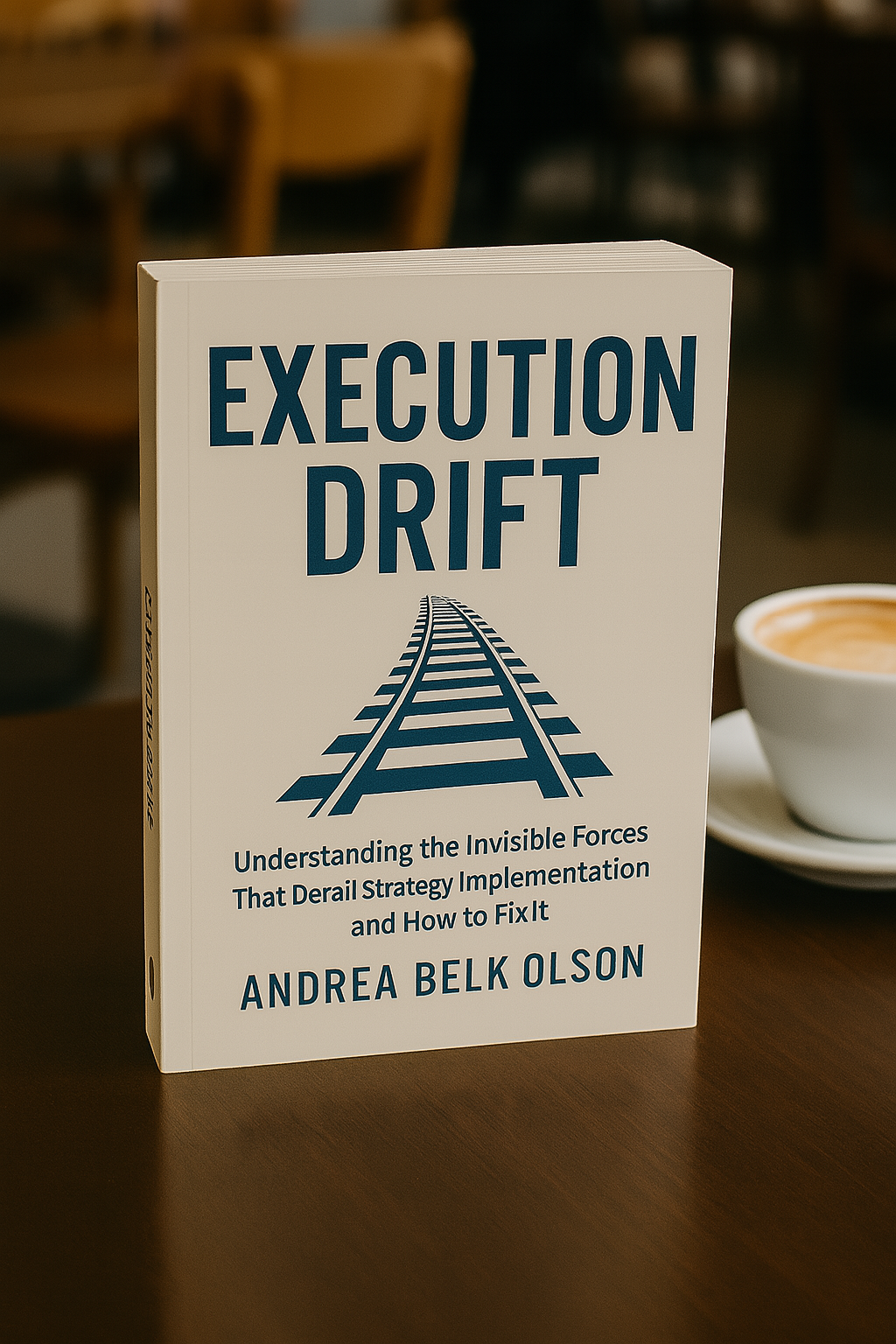
Any strategy comes to life through effective implementation. But the chasm between vision and action is what most companies struggle to cross. While we point to things like insufficient resources, poor communication, or a lack of accountability as the problem, what isn’t considered are the leadership behaviors that create the conditions for dysfunction. This book explores a long-term study which uncovered the three most detrimental behaviors, their impact on strategy execution, and how to stop them from derailing success.
The first behavior -- Idea Bombing -- is when leaders constantly launch new initiatives only to abandon them midstream for the next big idea. This teaches employees to wait out new directives rather than commit to them, since they’ll change in short order. I explore how Idea Bombing conflates constant motion for actual progress, and the insidious way it destroys an organization's ability to execute sustainable change.
The second behavior – Clouding – is where leaders craft broad strategies using ambiguous jargon. This causes widely varying interpretations of the strategy, resulting in fragmented execution because employees don’t have a clear line-of-sight from their work to strategic outcomes. I unpack real-world examples of Clouding -- including phrases like ‘foster collaboration’ and ‘create value’ -- how these abstractions create a false sense of alignment and obscure the implementation path for both leaders and employees.
The third behavior -- Sunshining -- emerges when leaders cling to an over-idealized view of the company and dismiss any perspectives that challenge their narrative. As a result, employees hold back from sharing candid customer needs or organizational issues which contradict the strategy. These blinders perpetuate an environment where silence equals safety, and ideas are stifled before they see daylight. I explore how this behavior forces employees into a false choice between compliance (doing what they’re told) or commitment (driving change because they believe they can make an impact).
When these behaviors spread beyond a single team through fleeting company-wide reorgs, tech upheavals, and process disruptions, it creates conflict between strategic objectives and departmental goals. It causes a corporate ‘Sophie’s choice’, forcing employees to choose between contradictory directives. I discuss examples of this trap, how it cultivates Fait Accompli (another damaging behavior), and ultimately a culture of change-resistance.
While some leaders occasionally experience moments of self-awareness, most fail to see how their own actions create confusion, fear, and stalled progress. Their dysfunctional habits often emerge under pressure, when leaders grasp for control by flooding teams with new ideas, vague visions, or forced positivity instead of providing clear strategic direction. And without a decision-making framework that defines priorities, tradeoffs, and success criteria, organizations fall into misalignment. But rather than trying to control or contain these behaviors, the better approach is using what psychologists call ‘sublimation’ – redirecting their underlying energy constructively. In layman’s terms, it means creating an actionable through-line to positively channel these behaviors.
Channeling these detrimental behaviors begins with creating a single, authentic"Guiding Principle". Your Guiding Principle serves as your strategy’s ‘center of gravity’. A good Principle must pass five tests: it must be a strategic truth applicable organization-wide, deliverable consistently over time, amplify a genuine differentiator rather than an aspiration, allow for creative interpretation, and address what audiences want and need. Through examples including Nike and Patagonia, I illustrate how companies use their Guiding Principle not as marketing slogans but as a decision-making filter.
The second step is creating three “Core Commitments” – expanding on your Guiding Principle. These don’t concentrate on a single function, product, or service, but rather illustrate what your entire organization commits to delivering consistently that embodies your Guiding Principle.
Core Commitments need to answer two questions: how can we embody our Guiding Principle to our customers’ benefit, and what valuable, differentiating outcomes does that create? Through a series of examples, I explore how they’re used to create a focused narrative, clarifying the interconnection between the organization’s unique strengths, customer needs, and the company’s strategic objectives.
Finally, there are the “Supporting Actions” -- nine concrete behaviors that explain how to live your Core Commitments everyday. They aren’t individual initiatives or tactics -- they illustrate how your Commitments become part of the company’s operating DNA. They represent what the entire organization should be doing and thinking every day.
Great Supporting Actions must do three things: provide clarity on what actions employees should take, explain the bigger purpose for those actions, and be measurable. I dive into examples of how leaders use their Supporting Actions as a decision-filter for initiatives, projects, and activities that drive strategy execution.
When you bring the three parts together, you get an organizational "Steering Guide”. The Steering Guide is a one-page canvas to explain the strategy’s ‘center of gravity’ (Guiding Principle), the steadfast organizational priorities (Core Commitments) and how everyone can live those priorities daily (Supporting Actions).
This serves as the strategy’s Rosetta Stone. It establishes consensus on what’s most important to customers, which organizational strengths to capitalize on, and how the company needs to behave to amplify it. I share real-world case studies showing how leaders use the Guide to align organizational mindsets, behaviors, and initiatives around a single strategic locus while preserving flexible implementation.
The Steering Guide corrals Idea Bombing, Clouding, and Sunshining behaviors in three distinct ways. First, it anchors strategy in a core strategic differentiator, enabling random suggestions (Idea Bombing) to pass through a simple alignment filter, rather than individual’s perceptions. Second, it clears the fog of vague and obscure jargon (Clouding) by defining specific commitments and concrete organizational behaviors. Third, it challenges over-idealized views (Sunshining) by grounding decisions in outcomes rather than corporate narratives. Through a series of client case studies, I illustrate how the Guide transforms performative strategy (which fosters these behaviors) into a universal, transparent, and aligned way of moving forward.
The Steering Guide isn’t solely for corporate leadership. It is also used by individual departments and teams to create their own ‘supporting strategies’ -- a set of strategically aligned initiatives and projects for their domain. These are prioritized using a TITE grid (Tolerate, Invest, Transition, Eliminate) assessment tool, ensuring the right ones come to the forefront.
I also dig into how the Guide is used to measure strategic execution and alignment on three levels; by individual initiatives (whether projects align with Core Commitments), by cultural performance (whether behaviors align with Supporting Actions), and by company performance (organization-wide KPIs tied to the Guiding Principle).
The Steering Guide doesn’t just help bridge the strategy-execution gap. It also helps shape organizational culture and change acceptance. Strategy only becomes culture when it drives how people make decisions, navigate challenges, and innovate within constraints. I discuss through a series of examples how the Steering Guide provides the clarity required to enable leaders and employees to think in new ways and explore different avenues of innovation.
You can also create your own Steering Guide, serving as a personal credo to demonstrate strategically aligned ways of working, thinking, and ideating. This enables individuals to positively influence their team’s culture through modeling strategically aligned behaviors.
"A must-read for any company navigating strategic change."
No matter the number of surveys, interviews, or studies conducted, we regularly fail to uncover those gems needed to make our organization stand out. It’s no surprise given that “expert” guidance states the obvious, like “Ask open-ended questions,” “Identify patterns,” or “Extract insights.”
What’s needed is a way to discover what we’re missing. Traditional customer feedback methods ignore two essential sources of insight: context and behavior. These reveal the WHY behind the WHAT, eliminating the ambiguity of open-ended customer feedback—and this requires a different approach.
In What to Ask, author Andrea Belk Olson delivers a unique, cognitive method for discovering hidden customer needs, converting them quickly into differentiators, and avoiding the pitfalls of traditional research.
Available in hardcover, digital and audio versions.
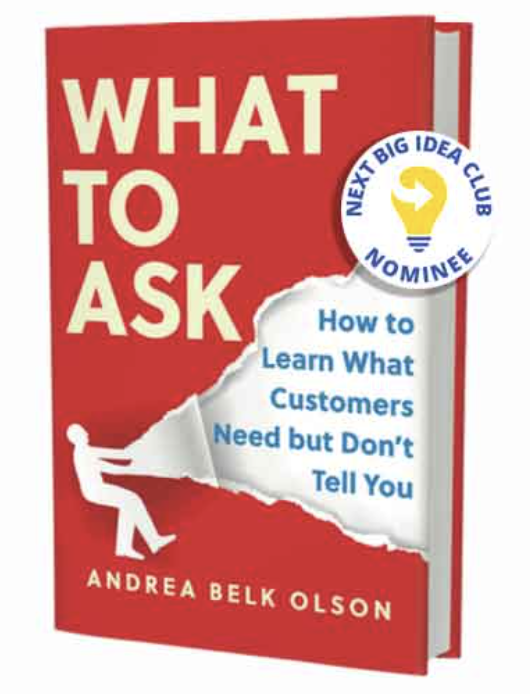
"A very thought-provoking look at how to better understand your customers. The book is full of fresh examples and practical case studies. Simply wonderful!”
“Andrea Olson cuts through the clutter of customer data noise and guides us squarely into their hearts and minds where, together, we can help discover the unspoken needs and desires they’ve yet to articulate. If you are competing in a space clamoring for insights about your customers, read this book. Twice. And Slowly.”
"What To Ask provides an enlightened view of the customer insight challenge that every single business today struggles with. And it delivers to-the-point, non-academic, no bullshit methods and guidance to address it.”
“What to Ask is a must read for business leaders and decision-makers at all levels and in every industry and an invaluable resource for entrepreneurs who are seeking to innovate and differentiate in emerging markets or in existing markets where current solutions no longer meet customers’ needs.”
“What to Ask is just what we need right now in the customer insights and marketing domain. Superior customer understanding is the new battleground for companies to gain a sustainable competitive advantage. This smart, practical guide leverages behavioral science to help you help customers reveal what really drives their decision-making, so that you have a real shot at impacting it.”
“A must-read guide for anyone who wants to know what their customers or employees want – what they really want. This is an excellent, contemporary reference manual for people measurement and all the foibles of human nature that go with it, brought to life in a fascinating and memorable way.”
“This book will help sharpen your customer focus. Incredibly immersive yet practical, it skips all the vague theories and delivers an immediately applicable method to shift organizational mindsets around customers and what they need now.”
“This is the best title of any marketing book. And the contents more than live up to the promise. It is a masterclass in learning to uncover the decisive distinctions and paradoxes in human behaviour which most businesses overlook to their cost.”
“I teach every entrepreneur that they must know their customer better than their customer knows themself. This is the first book that I’ve read that shows you exactly what that means and how to do it.”
"Needs, business models and competition are evolving at an ever-faster pace, making customer insight more important than ever to guide how companies evolve. Andrea Belk Olson explains cogently and with practicality how to understand customer needs in a world where technology creates the illusion that it’s “all in the data”."
“Any business needs to understand the behaviour of customers to succeed. But too many businesses go astray by asking them the wrong questions and get misleading answers (or none at all). In this insightful, entertaining, and practical book, Andrea Olson gives hugely useful and valuable frameworks to make sure the questions you ask about your customers give you the answers you need to drive business success.”
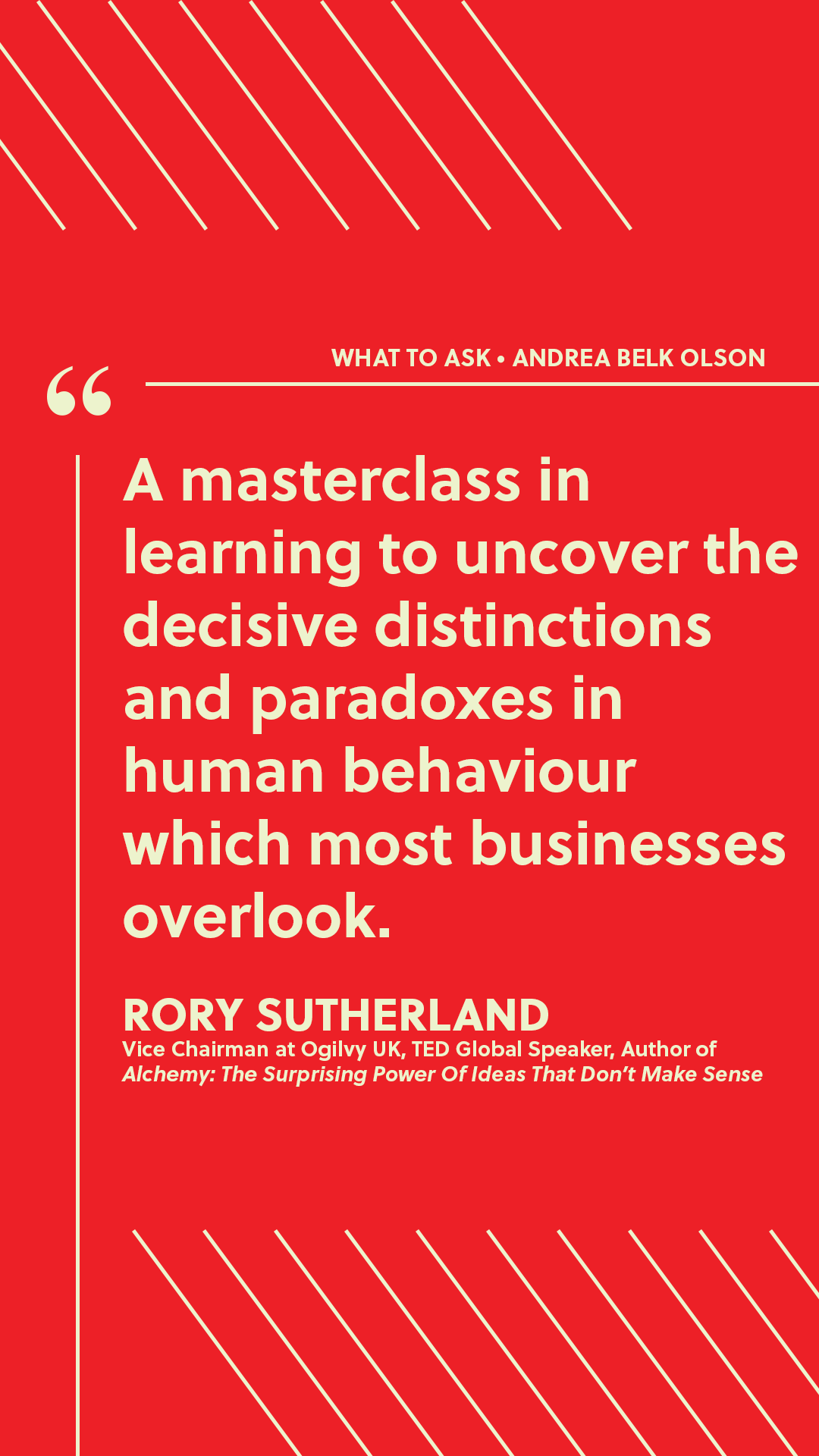
Distributed with tED Magazine Podcast
Behaviour Business Podcast
Lancefield on the Line Podcast
Office Hours with David Meltzer Podcast (47:48)
Scribble on NPR
Six Pixels of Separation Podcast
This Shit Works with Julie Brown
The Scott Becker Private Equity & Business Podcast
What's Next! Podcast with Tiffani Bova
InsideBE Book Feature
Next Big Idea Book Bite
Quad City Times Book Review
QRCA Book Review
HRW Book Review
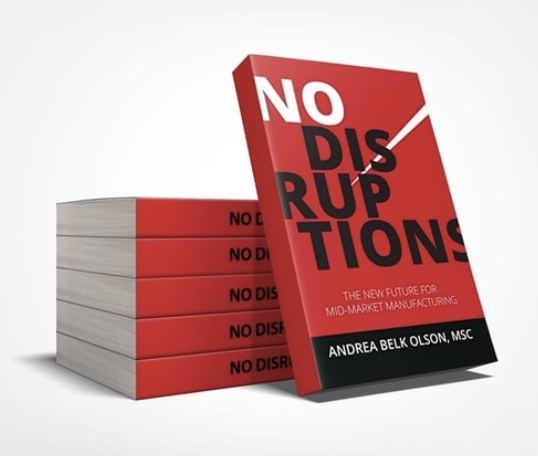
The first book to holistically examine the challenges of the skeptical, change-resistant, mid-market manufacturer, and how to overcome them.
ORDER YOUR COPY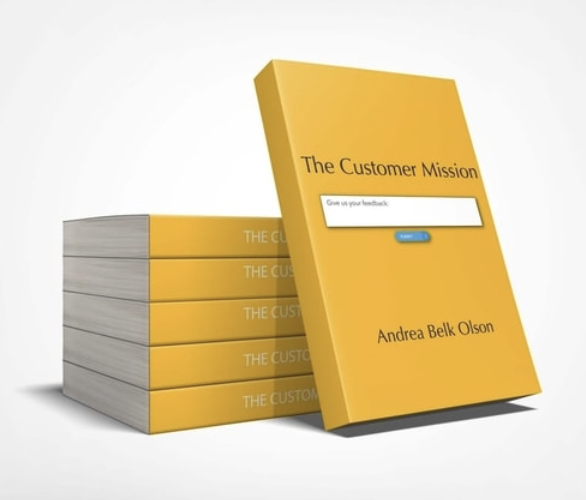
This book examines how to redefine your customer and how to redesign your organizational strategy to create uncontested differentiation.
ORDER YOUR COPY